WHAKAHORO
On the evening of March 19th 2010 many New Zealanders settled in to watch a popular TV show called Country Calendar. It featured the hard-slog activities of a tough young central North Island farmer named Dan Steele and chronicled his imaginative, innovative efforts to turn his central North Island farm into a profitable enterprise.
Whereas Dan admitted that the land was, by and large, unsuitable for farming and should never have been broken in for that purpose, he had found that the remote location offered plenty of other business opportunities. It had great scenic beauty, within an exquisite confluence of rugged high hills and serene valleys, through which multiple major rivers or small tributaries flowed. There was ample scope to see rare species of native fauna and flora, which had all but disappeared from other centres around New Zealand. This steep and difficult hinterland gave visitors a real glimpse of what much of New Zealand used to be like as untamed wilderness.
Dan had found that there was ample tourist potential amidst the rugged beauty of his remote, back-of-beyond farm and built several valley lodges for hunters, backpackers and nature-lovers. As a part of ongoing development, he envisioned that his farm also needed a high country lodge offering stunning views out to the three majestic volcano's of the central plateau eastwards or Mt. Taranaki to the West. During the filming sequence for Country Calendar he took the interviewer to this highest point of his farm ... and then things started to get particularly interesting.
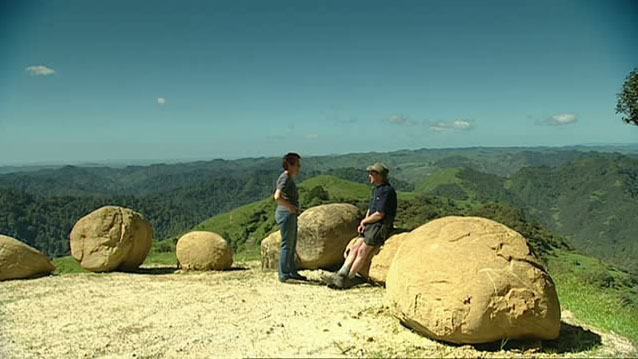
Dan Steele is interviewed at the highest point of his farm. In anticipation of building a lodge here a digger was brought up to create a flat spot. The machine had no sooner broken into the surface, than a series of similar sized concretion boulders were discovered in the surface material. These very interesting formations were carefully hooked out and set aside. as they could serve as a feature of the proposed lodge.
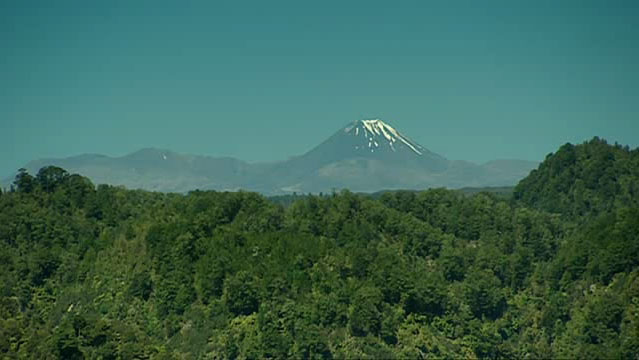
Lying directly East of the newly exposed, concretion boulder site were the two dormant volcano's, Tongariro (left) and Ngauruhoe (central).
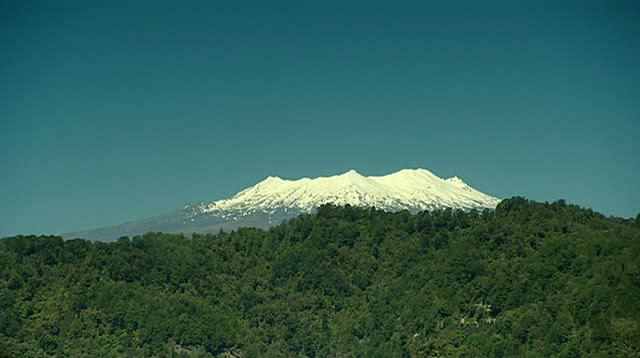
Further southeast is the volcano Ruapehu. All three volcano's are dormant (asleep) but wake up periodically.
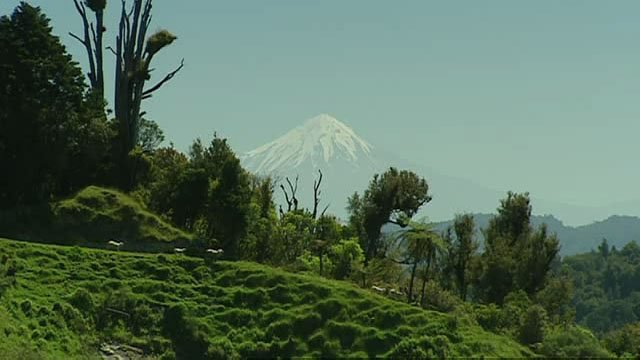
To the West is the volcano, Mt. Taranaki, which is also dormant ... for the moment!
SO, COULD THESE BOULDERS HAVE ANY ARCHAEOLOGICAL SIGNIFICANCE? LET'S GO SEE!
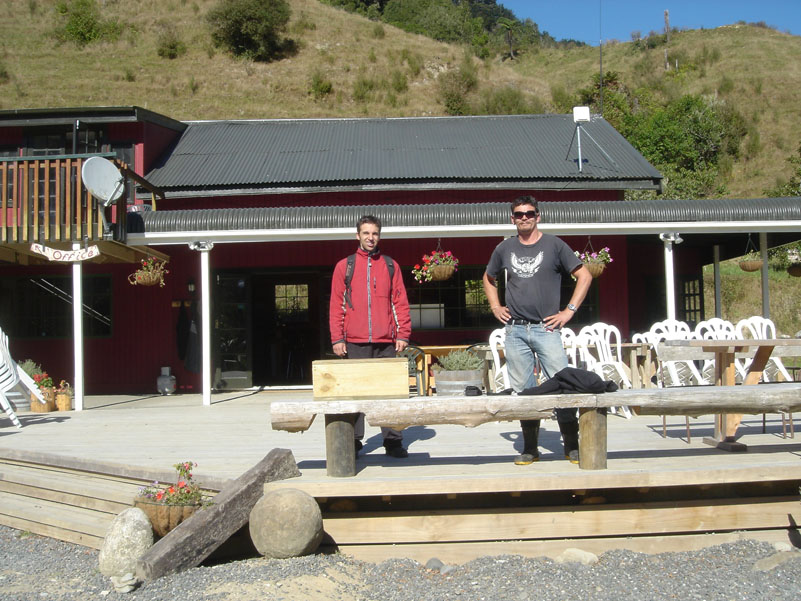
Gene Doutré and Russell Ireland standing outside "Blue Duck Central", Dan Steele's base of operations and restaurant-watering trough for intrepid hunters, kayakers, hikers and nature lovers, enjoying the great outdoors. Blue Duck Lodge was easy to get to, with tar-sealed roads almost all the way to the front door.
After viewing the Country Calendar coverage of the site and doing some preliminary calculations related to the position, a group of us headed off to check out the location. The evidence suggested that the eight boulders, removed from shallow encasing soil and all clustered together within a confined area of only about 50-feet X 50-feet, were once part of an ancient, purpose-placed solar observatory and trig.
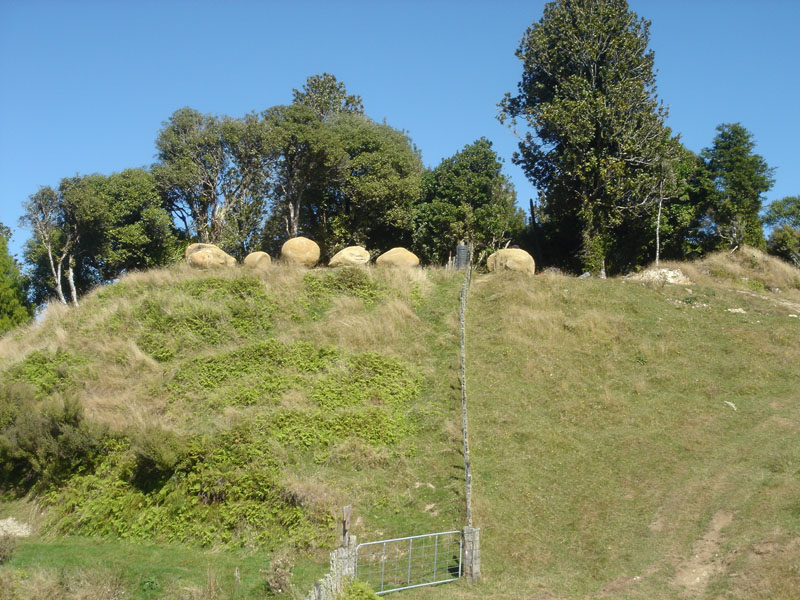
The eight boulders (six in full view) sit atop this small hill. To the right hand side of the picture a mostly undisturbed hump can be seen with a partial excavation into its side. This gives an indication of just how shallow the overall excavation actually was and how little flattening of the hilltop was required. Another, undisturbed concretion boulder, sits exposed behind the hump, bringing the total on this small expanse of terrain to nine large concretions.
SO, DID THE CONCRETION BOULDERS OCCUR THERE NATURALLY?
An exploration of the immediate area shows that there is no visibly apparent abundance of concretions and the only other two found nearby are quite solitary or individual and look like they've been artificially placed as markers. Some naturally occurring concretions were found semi-exposed at a lower level of a nearby hill, as we made our trek out. Those boulders and irregular fragments, breaking through the surface, were encountered about 1800-feet (550-metres) to the NNE.
According to a geologist this author has consulted, the local soils are made up of late Miocene Age sandstones and siltstones, dating to about 6-9 million years ago. Concretion boulders within the Whanganui River region are reasonably common and these ones, he felt, appear to be made up of calcareous sandstone, which often contain shell fragments
In commenting further about the photographic evidence showing the sub-strata in exposed embankments, the geologist stated that "The excavation seems to be the end of a narrow ridge and from what I can see the ‘grain’ or bedding in the rock is steeply dipping and the rock is well jointed. Concretions don’t usually occur in well jointed rockmasses but are found in thick ‘massive’ sediments, or like at Silverdale, in an undersea mudflow. So the stones at this site seem foreign to the rock mass".
Further to the above, the area has been showered with ash over millenniums, because of all the active volcano's in the region, which periodically blow their stacks and rain debris down onto everything. One could reasonably expect that a high hill like this would have received its fair share of volcanic tephra ash and that the top layers of soil and rock materials will be well coated in the stuff. The tephra material found all around the underside of one of the undisturbed concretions was very dark brown in colouration, as if subjected to high heat.
The preliminary geological assessment of samples taken at the site show an incidence of mica, as well as small dark stones that would be more consistent with what's found in volcanic rhyolites. This sample material is found to have coated the outer surface of the concretions. It also sits beneath one of the undisturbed concretions, indicating that the boulder is in foreign material not conduscive to its formation. The more general soil material upon which the eight, newly exposed boulders sit contains mica content and the evidence would suggest that the concretions were placed on top of an ash fall, rather than simply emerging naturally from the silt sedimentary material, essential to concretion formation and growth.
SO WHY GO TO ALL THAT TROUBLE OF HAULING BOULDERS TO THE TOP OF THIS HILL?
It was done to achieve the following effect:

Calculations completed using the astronomy program, Redshift 5, in conjunction with Google Earth and AutoCAD, show that the Sun at the Equinox will be seen to rise out of the cone of Mt. Tongariro from this boulder vantage point /solar observatory. "First glint" of the Sun should be in the southern side of the cone dip near the highest part of the mountain, with the sun then filling the cone as it ascends into the sky. Of course, direct observation at the time of the equinox sunrise is the only way to know the final refinements of sunrise with absolute certainty.
And so the concretion boulders at Whakahoro appear to be functioning in exactly the same manner as purpose-placed concretion around Silverdale, Waiwera and ranging into Northland, to the Mangamuka's. Throughout the North, the ancient Patu-paiarehe set up many solar observatories and special overland markers, using large, round concretion boulders. From this set at Whakahoro, the observation onto the equinox rise point is particularly clever, as it uses the fiery orb of the sun to cause a huge explosive fire to ascend from Tongariro's volcanic cone. The ancient Patu-paiarehe of the Auckland Isthmus caused the same thing to occur with the extinct volcano, Mt. Wellington, on the equinox days.
And further to that:
![]()
From the small plateau where the 8 newly exposed boulders sit, this is the view westwards towards Mt. Taranaki and the foothills that sit North of the mountain.
1. On this small mound, situated 300-feet from the main grouping, is yet another large concretion boulder. It is partially covered in tephra ash material from one of the many volcanic explosions that have occurred since the boulder was set in this position. From the main site it marks the exact degree angle to the cone of the mountain, which for much of the Winter months would be enshrouded in clouds or mist and invisible.
2. The cone of Mt. Taranaki, partially obscured by trees.
3. The point of Equinox sunset into the toe of the foothills of Mt. Taranaki.
![]()
This is the ash covered concretion that sits 300-feet from the main site and marks the exact degree angle to the cone of Mt. Taranaki. This concretion appears to have an old incised line in its surface.
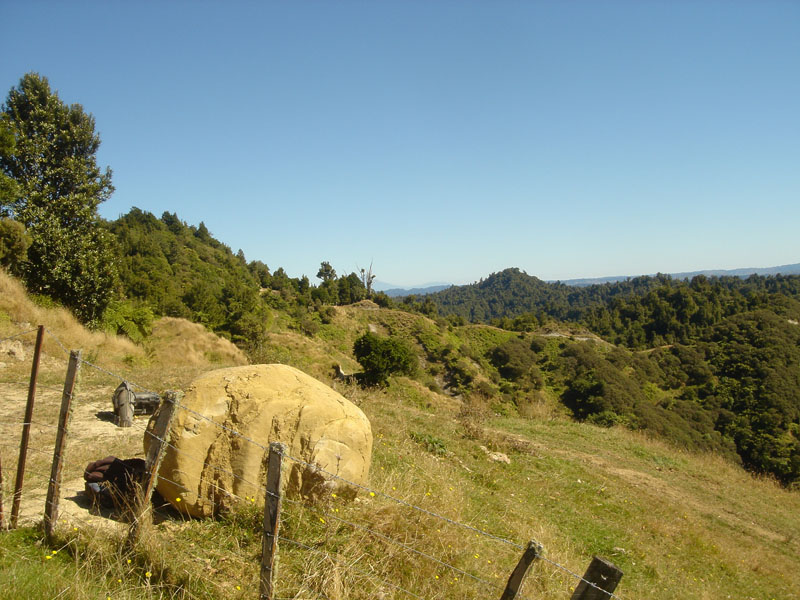
This is the overall view from the main batch of concretions, over the ash-covered outer marker concretion 300-feet away, to Mt. Taranaki, which is semi hidden behind a dead tree.
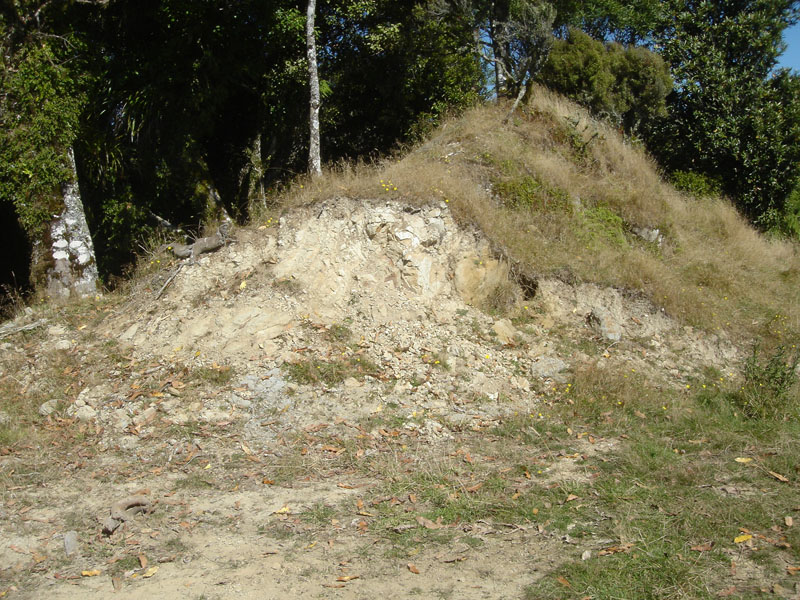
To the southwestern edge of the small site where the 8 boulders sit is another one of these humps, which the digger partially excavated when flattening out the hilltop. On the western side of the hump is yet another concretion, partially covered in what appears to be ash fallout. It was, undoubtedly, another alignment marker, seemingly working in with the one further West, to point towards the equinox sunset.
The shallow excavation shown represents the totality of top surface material cut down and, within this confined space of the hill's small crown, measuring about 50' X 50' (2500 square feet), 8 large concretion boulders were found clustered together.
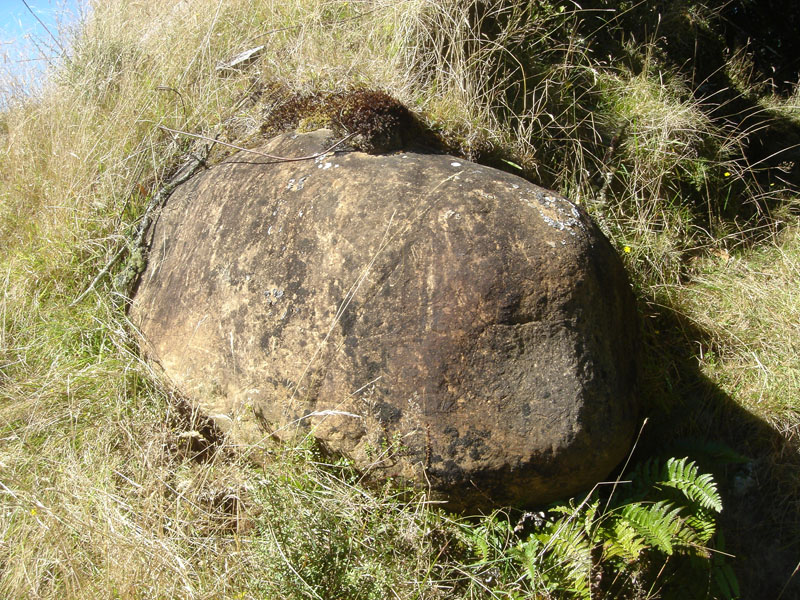
Here's the concretion on the western side of the hump. Samples of soil materials taken from the base of this boulder are very dark tephra ash from one of the volcanic explosion fallouts. There appears to be an incised line on the southern side of this boulder, which points towards a very prominent northeastern mountain, thought to be Mt. Hikurangi.
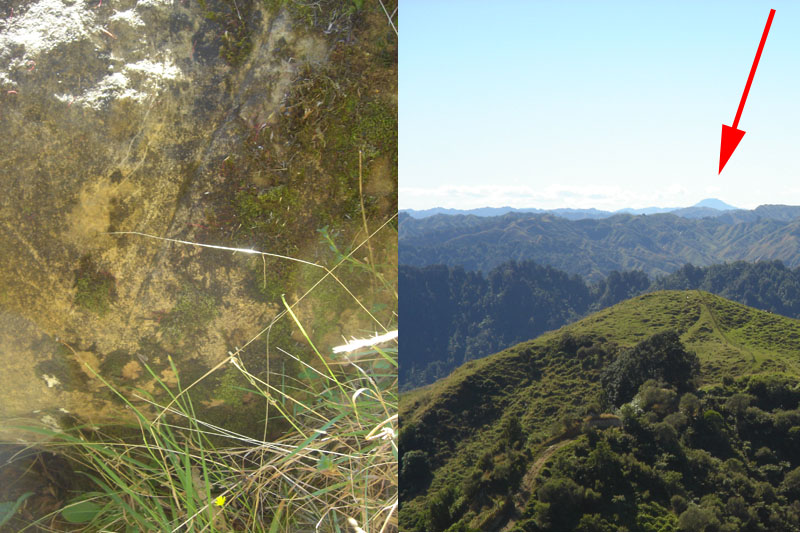
Left: Close inspection of this line leads one to believe it is incised rather than natural. Right: It seems to orientate directly towards this very prominent mountain.
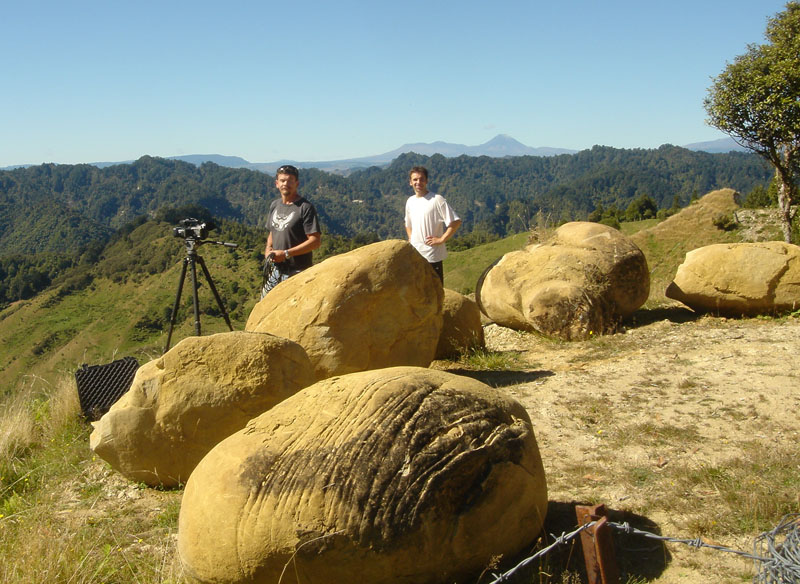
Russell & Gene set up the video camera and tripod to video the panoramic vista. Behind them to the East and ESE are the 3 big volcanoes of New Zealand's central plateau, as well as other prominent landmarks. This huge region of rugged, inhospitable terrain, with its cold, wet or snowy winters was the location where many early, pre-Maori inhabitants of New Zealand had to flee for sanctuary after the arrival of the Polynesian-Melanesian cannibals.
The very rugged badlands of the central North Island became the sanctuary for early Patu-paiarehe tribes fleeing from the Eastern coastline of New Zealand over in the Hawkes Bay District or from the western coastline around Taranaki. The Ngati-Hotu of Hawkes Bay, first fled to the inland lakes. In the Rotorua District this included lakes Rotorua, Okataina, Okareka, Tikitapu, Tarawera, Rotomarama, Rerewhakaaitu, Rotoehu, and Rotama. The Patu-paiarehe tribes seemingly subsisted well in the district and their underground dwellings or other structures can be found throughout the area to this day. On the Western side of Lake Rotorua they occupied the high ground of Ngongataha. Early 20th century historian, James Cowan, interviewed an old Maori kaumatua and learned of the fate of the Patu-paiarehe there. Cowan wrote:
'Patu-paiarehe is the name applied by the Maoris to the mysterious forest dwelling race. An atmosphere of mysticism surrounds Maori references to these elusive tribes of the mountains and the bush....The Patu-paiarehe were for the most part of much lighter complexion than the Maoris...their hair was of a dull golden or reddish hue, "uru-kehu", as is sometimes seen amongst the Maoris of today...This class of folk-tales no doubt originated in part in the actual existence of numerous tribes of aborigines. This immeasurably ancient light haired people left a strain of uru-kehu in most ancient tribes' (see The Journal of the Polynesian Society, 1921, volume 30, pp. 96-102, 142-151, article by James Cowan).
Commenting on a later era, Cowan interviewed an old Maori elder who spoke of the Patu-paiarehe of Mt. Ngongataha, Rotorua District. This partially wooded area rising above the south-west shore of Lake Rotorua was the main regional settlement of the Patu-paiarehe, whom the old elder called, Ngati-Hua (hua means "bastard" in Maori). The old elder described the former residents in the following way:
'The complexion of most of them was kiri puwhero (reddish skin) and their hair had a reddish or golden tinge we call uru-kehu. Some had black eyes, some blue like Europeans. Some of their women were very beautiful, very fair of complexion, with shining fair hair...'
Cowan was told by other Maori elders of the district that, many generations previously, the Maoris set fire to the fern and forest on the slopes of the mountain, causing much anguish to the Patu-paiarehe tribe and most of them departed northward.
J. M. McEwen researched one of these "Pakeha-Maori" (white Maori) tribes called the Ngati-Hotu for over 15-years and used for reference the writings of Hawkes Bay chiefs Raniera Te Ahiko and Paramena Te Naonao. Other researchers gleaned information from genealogical tables related by tribes bordering Lake Taupo and by interviews with the learned elders there. One quotation about the Ngati-Hotu, derived from these Maori sources, states:
“Generally speaking, Ngati Hotu were of medium height and of light colouring. In the majority of cases they had reddish hair. They were referred to as urukehu. It is said that during the early stages of their occupation of Taupo they did not practice tattooing as later generations did, and were spoken of as te whanau a Rangi (the children of heaven) because of their fair skin. There were two distinct types. One had reddish skin, a round face, small eyes and thick protruding eyebrows. The other was the Turehu. They had white hair and blue green eyes. They were fair-skinned, much smaller in stature, with larger and very handsome features.” (Tuwharetoa, Chpt. 7, pg. 115, by Rev. John Grace).
It's interesting to note that many very ornate little gable roofed, Saxon-style pataka buildings, a few of which are now preserved in the Auckland War Memorial Museum or at Te Papa Museum in Wellington, were seen abandoned and deteriorating on Mt. Ngongataha, by early colonial observers. These ornate structures were probably built for and by the very small white-pygmy people, as the doorways are tiny. Likewise, many gateways to villages had to be raised and widened in order to accommodate latter-era Maori occupiers.
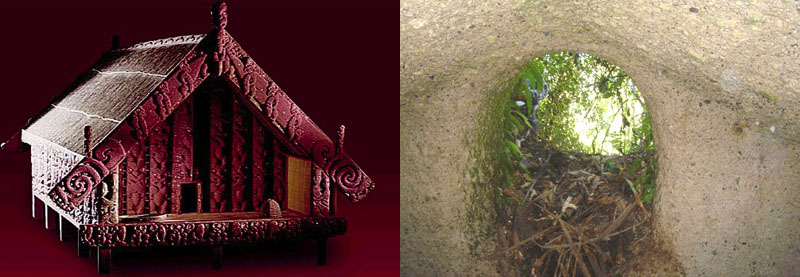
Many very ornate "pataka" houses were seen abandoned on Mount Ngongataha and other centres around New Zealand by early colonial explorers. The underground houses still found around all of the Rotorua lakes must number in their thousands.
The Turehu people of Taranaki were forced from their coastline possessions and into the foothills of Mount Taranaki, where they were hunted by the Polynesian-Melanesian warriors. They later fled further into the rugged interior above the Wanganui River (lately renamed the Whanganui River) around Matemateonga, near Whakahoro.
The white Ngati Hotu people fared no better after they fled further inland to Lake Taupo and Rotoaire. An old New Zealand map of Lake Taupo provides the following historical information on its border, which was gleaned from Maori oral- tradition history:
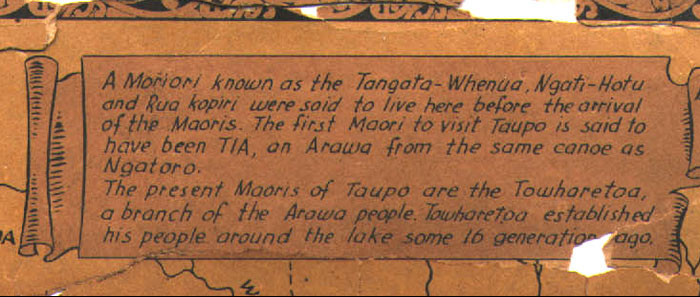
THE BATTLE OF THE FIVE FORTS.
Other traditions describe them as spirit people, which as is typical in Maori tradition, were of non-Maori appearance, having reddish hair and skin, symbolising their tapu nature.
Ngati Hotu were found living around the shores of lakes Taupo and Rotoaira by the Ngati Tuwharetoa iwi (tribe) in perhaps the 15th century. Ngati Tuwharetoa were then resident at Kawerau and associated with Te Arawa iwi which today occupies the area from the Bay of Plenty coastline to the Lake Taupo district. Ngati Hotu suffered a major defeat at the battle of Pukekaikiore ('hill of the meal of rats') to the southwest of Lake Taupo where Ngati Tuwharetoa devastated them, causing the few survivors to flee.
Apparently some of the survivors settled around the village of Kakahi ('freshwater mussels') which lies 30 kilometres west of Lake Taupo. They were discovered there by a party of Whanganui Maori journeying up the river of the same name, who soon called up reinforcements to attack the settlement. The Ngati Hotu set up a ring of five forts around Kakahi which the Whanganui Maori attacked and took one by one until finally the last two, Otutaarua and Arikipakewa, fell. The final, brutal episode of the battle was played out on the flats between Kakahi and the Whanganui river when the now, effectively victorious Whanganui Maori hung the legs of fallen Ngati Hotu warriors from poles mounted in the forks of trees - a gesture at which their remaining enemies broke and fled off into the depths of the King Country to vanish from history.
The battle is estimated to have occurred circa 1450 and its story has since been handed down through 15 generations to the Whanganui kaumatua Takiwa Tauarua, who related it to prominent New Zealand artist Peter McIntyre in the 1960s (See, Ngati Hotu, Wikipedia).
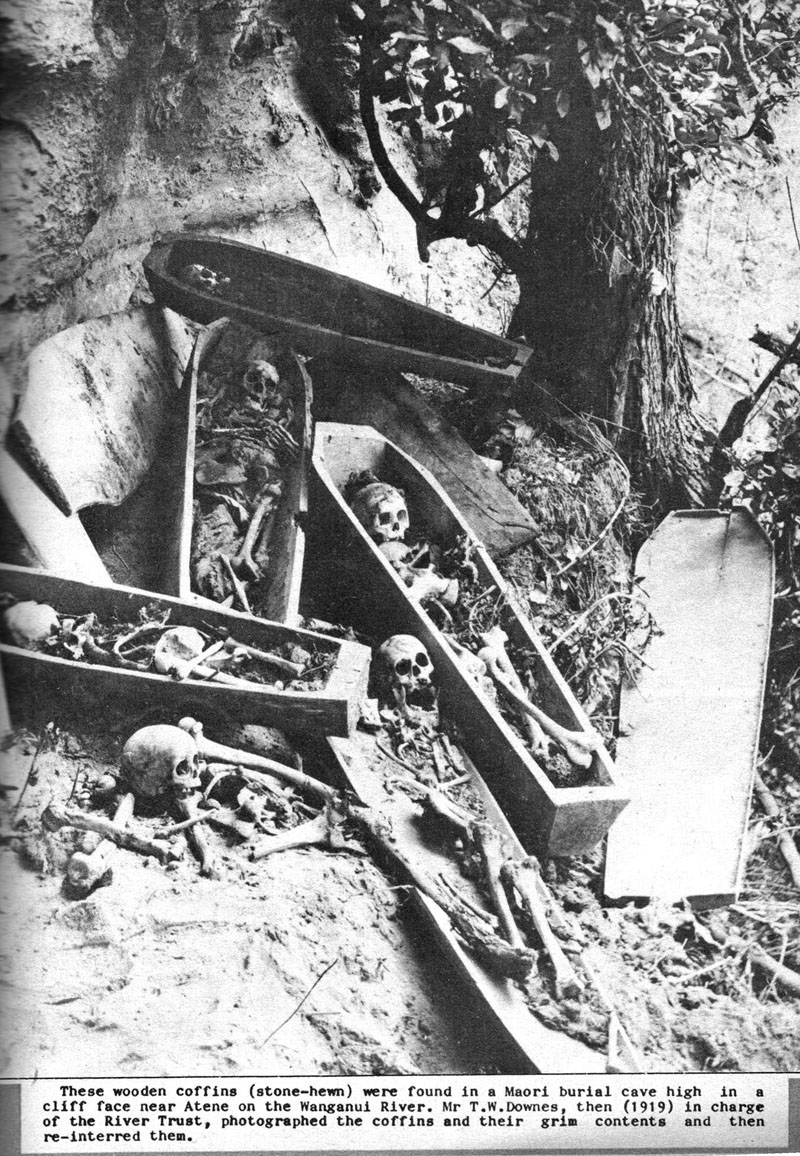
Photo courtesy of Rob Graham - Wanganui Photo News.
The coffins seen above were photographed in 1919 high up a cliff-face in a very remote and isolated part of New Zealand. Each coffin was hewn by stone tools from a single log, like a dugout canoe. These coffins were not “planked” or made from sawn timbers, as one would expect colonial European coffins to be fabricated at any point during the colonial era.
The coffin lids, seen above, were also hewn from a single, thick plank, with the edge “lip” (used for locking the lid firmly onto the coffin box) carved by scalloping out the central region. The cultural habit of carving coffins in this manner, as single hewn pieces, is reminiscent of the "mummy boards" of Egypt, which encased the body of the deceased. One skeleton lies on what appears to have been the base of an old canoe.
These skeletons are recognisable European physiology. They were already very old when found in rugged country, far from the consecrated ground of any European churchyard. These people were obviously the white Ngati Hotu, known in local Maori and European folklore to have hidden from the cannibals for centuries in this inhospitable central North Island region.
The location of this isolated burial cave or shelter was less than 50-miles further into the rugged badlands interior from where the last of the Ngati Hotu tribe were defeated and cannibalised in the “Battle of the Five Forts” at Pukekaikiore (hill of the meal of rats). A blowup of the picture positively shows a side view of a jaw (mandible) adjacent to the canoe base, which is not Maori, but European. The Maori Polynesian predominantly had a “rocker jaw” with a continuous downwards curve on the lower border. Further to that, the eye sockets of these people are squarish, the nose openings pyramidal, the faces long and narrow (dolicephalic skull type) and the craniums very round. The face line from the jaw past the nose and brow is consistent with the European facial profile, rather than the very flat face of the Maori.
Old colonial families living around the Atene area were conversant with the legends related to the Patu-paiarehe tribes hiding for generations in the rugged badlands around this remote and isolated region of New Zealand.
Geologists and other researchers are encouraged to go to the Whakahoro site and undertake their own analysis of this solar observatory. To do so, contact Blue Duck Lodge at: www.blueducklodge.co.nz
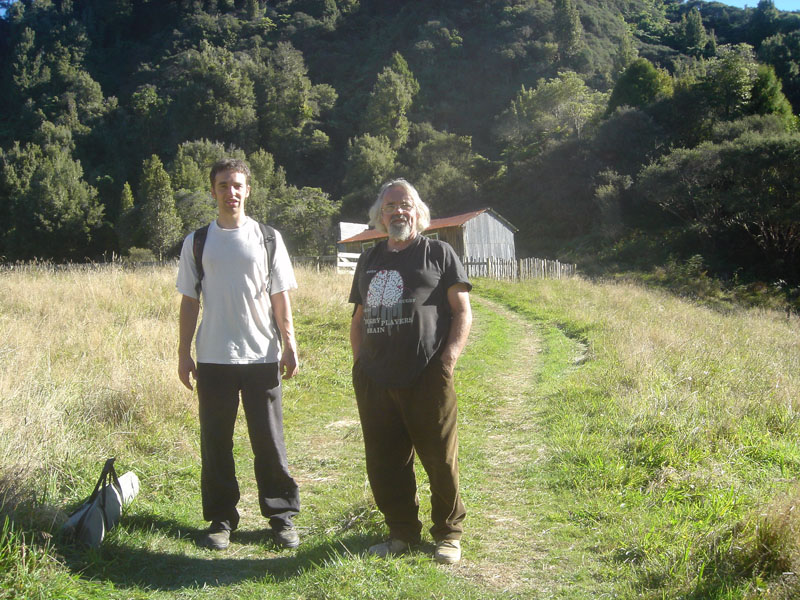
The author (right) and Gene, making the long trek out from the solar observatory. We have just passed by one of the historic cottages, abandoned by WW1 veterans who tried to break this picturesque but rugged country in for farming. By about the 1940's, most had to simply let the cleared land revert back to bush and walk away from the failed farms defeated.
Martin Doutré, May 2010.